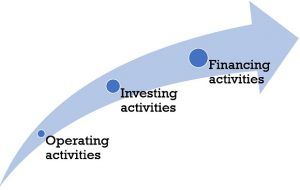
These are financial measures companies use to determine which investment option may be better than another or which asset may be a better acquisition for the company than another.

This way, if Investment A offers a higher incremental net income than Investment B, then Investment A should be favored.Ĭompanies tend to assess the viability of an investment project by calculating a project’s net present value (NPV), internal rate of return (IRR), and payback period.
Expected cash flows from the investmentĮssentially, what you are trying to assess is the net cash flow from incoming and outgoing cash during the life of the investment compared with other investment options or choices. In order to determine a cash flow a project or investment may provide a company, you must look at the following elements: Let’s see how incremental cash flows work so we can better understand the concept. There are many factors that can affect a company’s incremental cash flow, such as: Using the incremental cash flow analysis is not the only method of assessing the profitability or value of a new business venture but it’s a good starting point. Many companies use the “incremental” cash flow analysis to determine, at a high level, if the investment in a new project or asset may be worth it for the company. On the other hand, if the incremental cash flow is negative, it means that the firm expects to inject cash into the project.Īs a result, if a project offers a company positive cash flow, it is a good sign that the project may be good for business. If the incremental cash flow is positive, it means that the company will see an incremental rise in its cash flows. To make sure your projection stays accurate throughout the year, be sure to consider these variable expenses.An “incremental cash flow” is a finance and accounting term used to refer to the additional cash flow a company expects to receive (or have to disburse) on a specific project. Even if your actual numbers come in higher than your projections, you should take a close look at your assumptions, because higher returns in the short term could lead to shortfalls later on. A 5% variance one way or the other can be okay, but if it starts being more than 5%, you should revisit your key assumptions to check for flaws in your logic. 60% of eligible receivables can be used for the revolving line of credit.Īs the months pass and you compare your monthly cash flow statements to your projections for each month, the numbers should match up. 25% of sales will be collected the 2nd month after the sale. 75% of sales will be collected the month after the sale. What can you do today to prevent the negative cash flow?* :max_bytes(150000):strip_icc()/dotdash_Final_Free_Cash_Flow_FCF_Aug_2020-01-b760da2ee7244a7093d6df0804bb361b.jpg)
*The company is projecting negative cash in November. Here is an example of a cash flow projection that has been abbreviated to 4 months for the sake of simplicity: If you see a negative number for one of the months, don't panic: You have time and options to prepare your business. If you see positive numbers across the board, congratulations! You may have some extra dollars to invest back into your business. Excess (deficit) of cash: This is the number that counts.
 Total uses of cash: Tally all your expenses so you can see exactly what will be going out the door each month. Uses of cash: List every likely expense your business may incur, such as payroll, accounts payable to vendors, rent and loan payments, etc. Total sources of cash: Add the amounts in the "Operating cash, beginning" row to the amount in the "Sources of cash" for each month. Sources of cash: All money coming in each month (receivable collections or direct sales, loans, etc.). Operating cash, beginning: The amount of money you'll have at the beginning of each month. Then, in another column on the left-hand side, list the following cash flow categories and enter the appropriate amount in each column for each month (see descriptions below).: To get started, create 12 columns across the top of a spreadsheet, representing the next 12 months. With these realistic assumptions in hand, you can begin drafting your cash flow projection. Only the most likely numbers should appear on your spreadsheet. Don't let optimism factor into your key assumptions.
Total uses of cash: Tally all your expenses so you can see exactly what will be going out the door each month. Uses of cash: List every likely expense your business may incur, such as payroll, accounts payable to vendors, rent and loan payments, etc. Total sources of cash: Add the amounts in the "Operating cash, beginning" row to the amount in the "Sources of cash" for each month. Sources of cash: All money coming in each month (receivable collections or direct sales, loans, etc.). Operating cash, beginning: The amount of money you'll have at the beginning of each month. Then, in another column on the left-hand side, list the following cash flow categories and enter the appropriate amount in each column for each month (see descriptions below).: To get started, create 12 columns across the top of a spreadsheet, representing the next 12 months. With these realistic assumptions in hand, you can begin drafting your cash flow projection. Only the most likely numbers should appear on your spreadsheet. Don't let optimism factor into your key assumptions.



:max_bytes(150000):strip_icc()/dotdash_Final_Free_Cash_Flow_FCF_Aug_2020-01-b760da2ee7244a7093d6df0804bb361b.jpg)



 0 kommentar(er)
0 kommentar(er)
